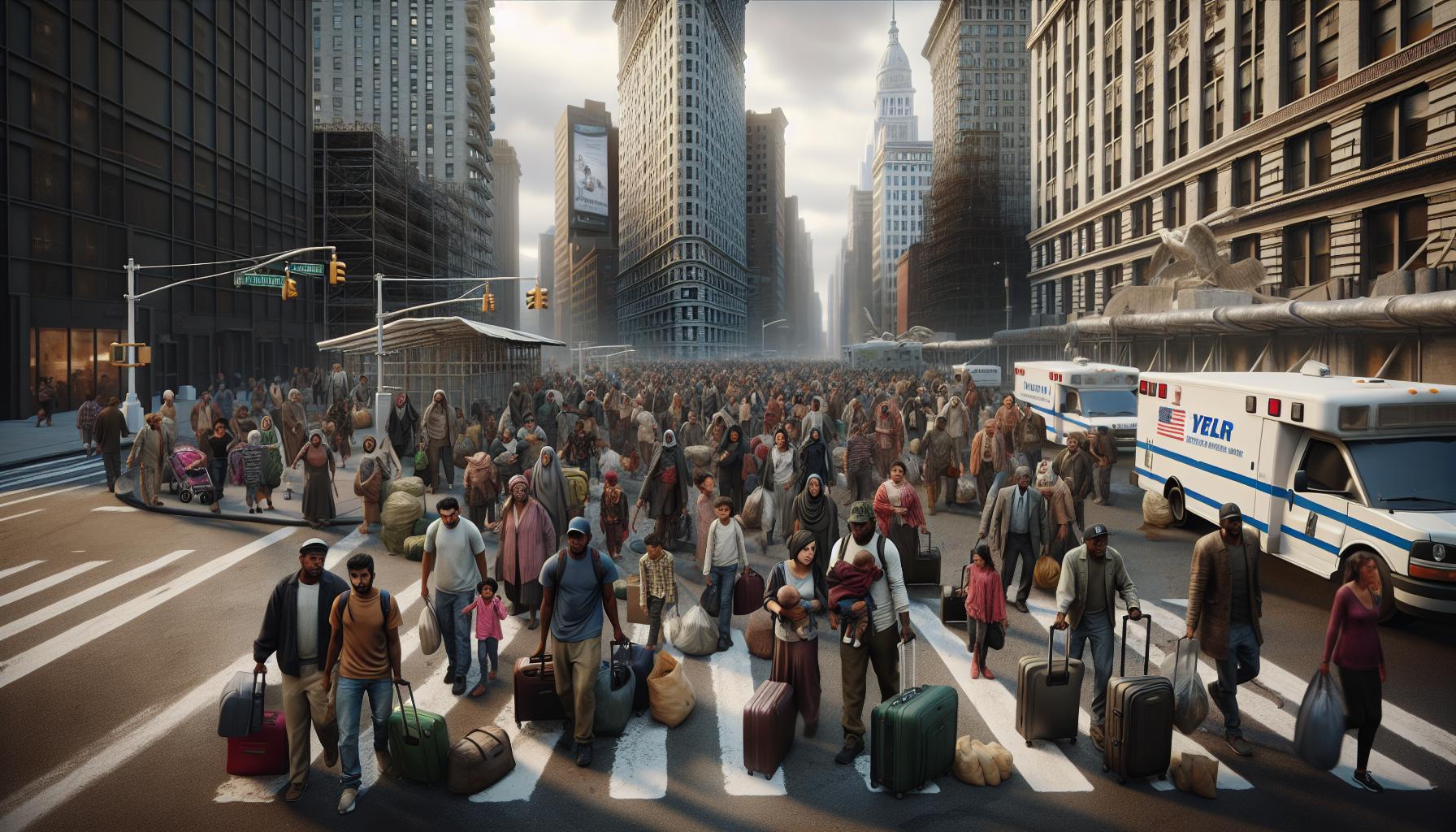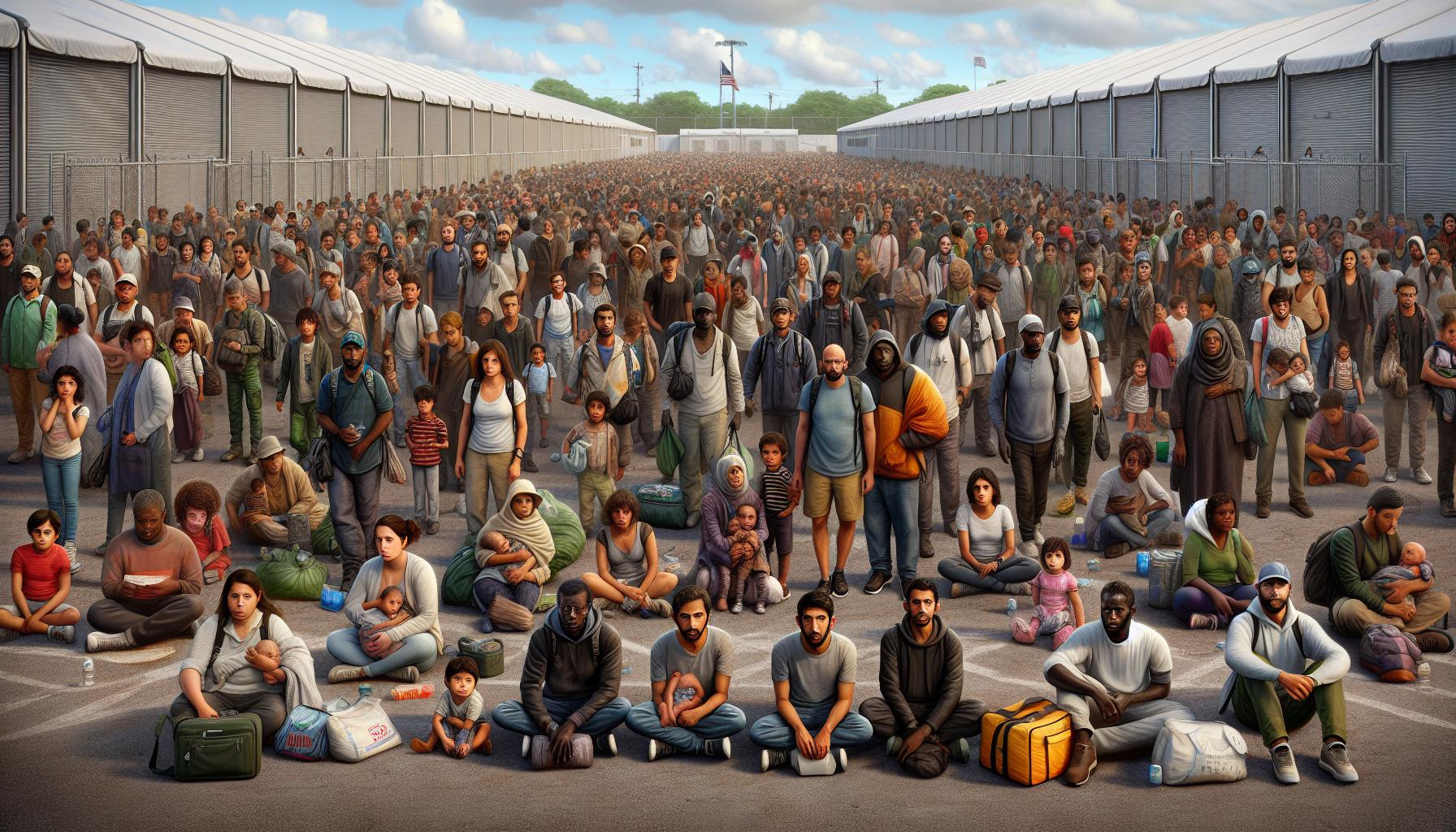The Best Fluffy Pancakes recipe you will fall in love with. Full of tips and tricks to help you make the best pancakes.

NYC Migrant Crisis: 57,000 Asylum Seekers Push City to Breaking Point
New York City faces an unprecedented challenge as thousands of migrants continue to arrive daily, seeking refuge and opportunities in the Big Apple. The city’s resources are stretched thin with shelters reaching capacity and local communities grappling with the impact of this humanitarian situation.
Mayor Eric Adams and city officials are working to address this crisis while maintaining a delicate balance between providing humanitarian aid and managing the city’s limited resources. The influx has sparked heated debates about immigration policies, public spending and the city’s ability to accommodate newcomers while serving its existing residents. From emergency shelters in former hotels to makeshift facilities in school gymnasiums, New York’s response to this migrant surge continues to evolve as officials search for sustainable solutions.
New York’s Migrant Crisis Overview
New York City faces unprecedented challenges in managing the surge of migrants, with over 100,000 asylum seekers arriving since spring 2022. The crisis strains municipal resources while testing the city’s capacity to provide humanitarian assistance.
Current Immigration Statistics
The Department of Social Services reports 57,300 migrants in the city’s care as of October 2023. Daily arrivals average 300-500 people, with peaks reaching 800 newcomers per day. Manhattan hosts 43% of shelter facilities, followed by Brooklyn at 28% and Queens at 19%. The demographic breakdown shows:
| Category | Percentage |
|---|---|
| Single adults | 65% |
| Family units | 30% |
| Unaccompanied minors | 5% |
Impact on City Resources
The migrant crisis costs New York City $9.8 million daily for shelter operations maintenance food services. Emergency shelters now occupy 150 hotels across the five boroughs. The strain extends to:
| Resource Category | Impact |
|---|---|
| Housing Budget | $1.45 billion spent in FY2023 |
| Education System | 19,000 migrant children enrolled |
| Healthcare Services | $137 million in medical care |
| Social Services | 4,200 additional staff deployed |
The Office of Management reports a projected $12 billion in total crisis-related expenses through 2025. Municipal services face reallocation of funds from existing programs to address immediate humanitarian needs.
Mayor Adams’ Response to Migration Surge

Mayor Eric Adams implemented decisive measures to address New York City’s escalating migrant crisis through emergency declarations and strategic budget allocations.
Emergency Declarations
Mayor Adams issued multiple emergency orders starting in October 2022 to expedite the city’s response to the migrant influx. The executive order suspended specific land-use requirements enabling rapid shelter construction and facility conversions. The administration established 200+ emergency sites including hotels, schools and community centers to accommodate migrants. A subsequent order in May 2023 relaxed shelter capacity limits allowing facilities to house more individuals temporarily. The emergency declarations authorized $1.4 billion in no-bid contracts for shelter operations, food services and transportation support. These orders remain active, providing flexibility to manage the continuous arrival of 300-500 migrants daily.
| Budget Category | Amount (FY2023-2025) |
|---|---|
| Emergency Housing | $1.45 billion |
| Healthcare Services | $137 million |
| Education Support | $89 million |
| Transportation | $43 million |
| Security Services | $38 million |
Housing Challenges and Solutions

New York City’s migrant housing crisis demands innovative solutions as traditional shelter systems reach capacity limits. The city’s Department of Housing Preservation faces unprecedented challenges in providing safe accommodations for thousands of asylum seekers while maintaining services for existing residents.
Emergency Shelter Programs
Emergency shelter initiatives transformed 200+ locations into temporary housing facilities across New York City’s five boroughs. Hotels like the Roosevelt Hotel serve as intake centers, processing 500 migrants daily while providing basic necessities. The Humanitarian Emergency Response and Relief Centers (HERCs) operate at locations including Floyd Bennett Field in Brooklyn, housing 2,000 migrants in climate-controlled tents. The city partnered with faith-based organizations to create 50 smaller shelter sites, accommodating 100-200 people each. Recent programs include the Asylum Seeker Resource Navigation Center, connecting migrants with housing assistance programs through a centralized database system.
Controversy Over Housing Locations
Local communities express concerns about the impact of migrant shelters on neighborhood resources. Residents in Staten Island filed three lawsuits challenging shelter placements near schools. Queens communities reported overcrowding issues at former hotels converted into shelters, particularly along Queens Boulevard. Business owners near Times Square documented a 30% decrease in foot traffic following shelter installations. Brooklyn residents contested the Floyd Bennett Field location, citing infrastructure limitations. Community boards across Manhattan raised objections to shelter density, with specific protests focusing on clusters in Midtown East where seven facilities operate within a 10-block radius.
Economic Impact on New York City
New York City’s financial stability faces unprecedented strain from the migrant crisis. The surge in asylum seekers creates substantial economic pressures on municipal resources across multiple sectors.
Cost of Supporting Migrants
The daily cost of migrant support reaches $9.8 million for shelter operations. Current projections indicate total expenses of $12 billion through 2025, encompassing housing, healthcare, education services. The FY2023 budget allocates $1.45 billion for emergency housing programs. Additional expenditures include $137 million for healthcare services, $89 million for education support, $43 million for transportation systems. Emergency shelter contracts total $1.4 billion for operations, food services, transportation support. The city spends an average of $383 per migrant per day on basic services, accommodation costs. Municipal services face budget constraints from supporting 57,300 migrants in city care.
Federal Aid Requests
New York City officials submitted requests totaling $4.6 billion in federal assistance for migrant-related expenses. FEMA allocated $140 million through its Emergency Food and Shelter Program in 2023. Mayor Adams secured additional funding of $104.6 million from the U.S. Department of Homeland Security. The city’s appeals resulted in a $30.5 million grant for humanitarian relief efforts. Senator Chuck Schumer advocates for increased federal support, citing the $363 million allocated for emergency shelter operations. State authorities matched federal contributions with $162 million in emergency aid. Current federal reimbursement covers 30% of actual migrant-related expenses.
Community Response and Integration Efforts
New York City’s migrant crisis has sparked diverse community reactions ranging from active support to organized opposition. Local organizations religious groups civic associations have mobilized to address the immediate needs of asylum seekers while some neighborhoods express concerns about resource allocation infrastructure strain.
Support Organizations
Faith-based organizations across NYC operate 50 volunteer-led welcome centers providing essential services to migrants. Catholic Charities coordinates daily meal distributions serving 3,000 individuals at 15 locations throughout Manhattan Brooklyn. The New York Immigration Coalition connects 800 migrants weekly to legal services employment assistance through their network of 25 partner organizations. Muslim Community Centers in Queens offer language classes to 450 newcomers enabling faster cultural integration. Local food banks distribute 200,000 meals monthly specifically designated for migrant families partnering with 75 community kitchens citywide.
Local Opposition
Community boards in Staten Island Brooklyn have filed 12 formal complaints regarding shelter placements near schools residential areas. Neighborhood associations report 40% increased congestion around converted hotel shelters particularly in Queens Midtown Manhattan. Property owners cite a 25% decline in rental inquiries within three blocks of large migrant facilities. Public meetings draw crowds of 300+ residents expressing concerns about emergency shelter locations impact on property values. Business associations in affected areas document 15% reduced customer traffic attributing the decrease to shelter proximity. Resident groups have organized 35 demonstrations against proposed shelter sites citing infrastructure capacity safety concerns.
Legal Battles and Policy Changes
New York City faces multiple legal challenges regarding its migrant response policies, with court cases at state and federal levels shaping the evolving landscape of immigration regulations.
State and Federal Court Cases
A class action lawsuit filed in Manhattan Supreme Court challenged Mayor Adams’ right-to-shelter modifications in October 2023. The Legal Aid Society represents migrants in several cases, including a suit against the 60-day shelter limit policy implemented on October 15, 2023. Federal courts oversee challenges to asylum processing procedures, with 3 cases pending in the Southern District of New York. Staten Island officials filed litigation opposing shelter placement at former schools, resulting in temporary restraining orders. The New York Civil Liberties Union secured an injunction in September 2023 protecting migrants’ access to legal representation during shelter applications.
New Immigration Regulations
The Department of Homeland Security introduced expedited work permit processing for asylum seekers in September 2023. New York State expanded legal aid funding by $20 million to support migrant cases through recognized organizations. The Temporary Protected Status program received updates allowing 472,000 Venezuelan migrants to apply for work authorization. City regulations now require shelter operators to provide language access services in 5 primary languages. Local law amendments streamlined shelter intake procedures through digital documentation systems connected to federal databases.
Conclusion
New York City’s migrant crisis represents an unprecedented challenge that continues to test the city’s resources infrastructure and community resilience. The city’s response through emergency declarations shelter expansions and comprehensive support services demonstrates its commitment to humanitarian aid despite mounting costs and logistical hurdles.
As the situation evolves city officials must balance the needs of both newcomers and existing residents while seeking sustainable long-term solutions. The ongoing debate surrounding resource allocation community impact and policy effectiveness will likely shape New York’s approach to immigration and social services for years to come.
The path forward requires continued collaboration between local state and federal authorities alongside community engagement to address this complex humanitarian challenge that’s reshaping America’s largest city.
